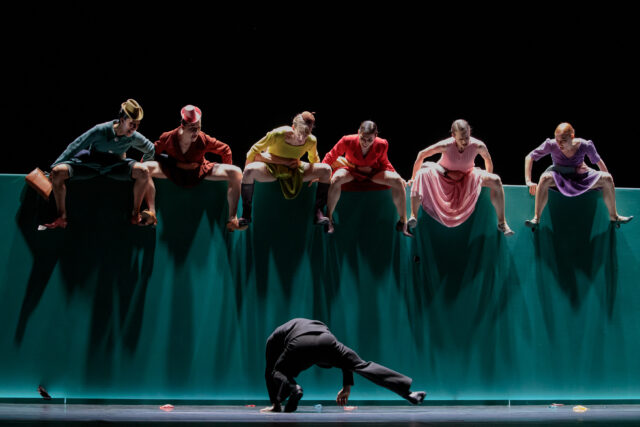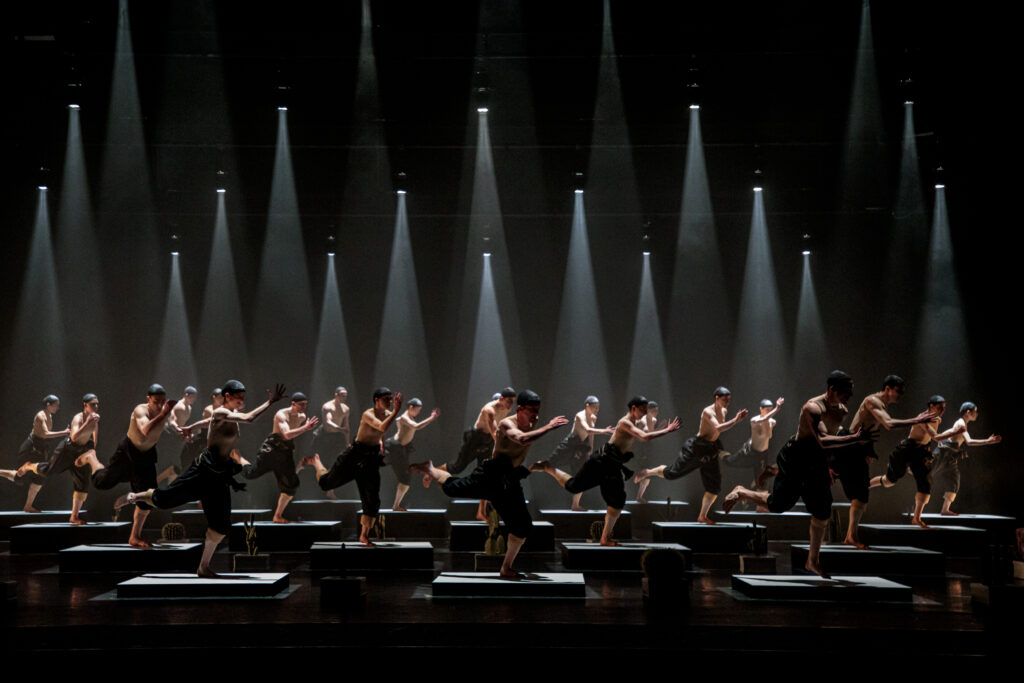
BERLINO – Nei mesi di febbraio e marzo 2023 presso la Deutsche Oper Berlin lo Staatsballett si cimenta con due lavori di coreografi svedesi: A Sort of… di Mats Ek e Cacti di Alexander Ekman.
La prima è una coreografia che affronta il tema del gender
A sort of…, che debuttò nel 1997 presso il Nederlands Dans Theatre, è una brillante coreografia che affronta il tema del gender in modo provocatorio (per quei tempi) e con una buona dose di ironia.
Lo spettacolo inizia con un ballerino, in cappotto da donna rosa, che si muove ‘tristemente’ sul palco. Inaspettatamente, dopo essersi sdraiato sul pavimento e aver vagato inutilmente nello spazio, si dirige verso il pubblico e solleva una donna, in completo da uomo marrone, portandola in scena con sé. Dopo aver ‘dialogato’ con lei sulle note di Henryk M. Górecki, riceve un biglietto e, chiusa la donna in una valigia, varca la piccola porta che li conduce in un luogo ampio, pieno di suoni e di persone. Da questo momento, i sedici danzatori sul palco si esibiscono in soli, duo, trii e coreografie di gruppo piene di colore, ritmo, salti, prese e corse, dando vita a brevi storie e a molte scene divertenti. Tra queste è emblematica quella in cui, come se si volessero cancellare i connotati anatomici di genere, esplode la pancia di una donna in cinta, il rigonfiamento inguinale di un danzatore e il seno di un’altra ballerina. Il pezzo termina nello stesso ambiente triste dell’inizio, ma con il protagonista nei suoi abiti ‘normali’ e senza la sua compagna.
La seconda una parodia sul modo di osservare l’arte
Dopo l’intervallo lo Staatsballett si esibisce in Cacti, coreografia di Ekman del 2010, che è già stata portata in scena da 20 compagnie di danza in tutto il mondo.
Il pezzo inizia con quattro musicisti che suonano dal vivo viole e violini e una ballerina che si muove tra loro molto lentamente. Dopo pochi istanti, la fossa dell’orchestra si apre ed emergono 26 ballerini inginocchiati ognuno su un basso piedistallo. Subito iniziano a muoversi a ritmo della musica che accompagnano loro stessi con forti respiri, battiti di mani, percuotendo le pedane sulle quali si trovano o i loro stessi corpi. Quando i musicisti escono di scena, i ballerini – che sono vestiti tutti con una tuta beige e la testa coperta da una cuffia nera – trascinano i piedistalli sul palco e iniziano a danzare a volte all’unisono a volte seguendo canoni. Attraverso un gioco di luci vengono illuminati tutti o solo alcuni di loro. Quando li sollevano, gli stessi piedistalli si trasformano in specchi che riflettono le luci verso la platea. Come suggerisce il titolo, ognuno porta un cactus in scena. Poi, i piedistalli vengono disposti in una interessante geometria e, mentre una voice over riproduce la conversazione di due ballerini, gli stessi danno vita a un esilarante duo, volutamente didascalico e di raffinata tecnica contemporanea.
Cacti è una coreografia di straordinario effetto visivo, di grandissima energia, ma soprattutto, come lo stesso Ekman dichiara, una parodia sul nostro modo di osservare e di comprendere l’arte.

In February and March 2023 at the Deutsche Oper Berlin, the Staatsballett performs two pieces by Swedish choreographers: A Sort of… by Mats Ek and Cacti by Alexander Ekman.
A sort of…, debuted in 1997 at the Nederlands Dans Theater and is a brilliant choreography that addresses the issue of gender in a provocative way (for those times) and with a good amount of irony.
The show begins with a dancer, in a pink women’s coat, moving ‘sadly’ across the stage. Unexpectedly, after lying down on the floor and wandering uselessly in the space, he walks towards the audience and lifts up a woman, in a brown man suit, onto the stage with him. After having a ‘dialogue’ with her on the notes of Henryk M. Górecki, he receives a ticket. He closes the woman in a suitcase and goes through the small door that leads them into a large place, full of sounds and people. From now on, the sixteen dancers on stage perform solos, duos, trios and choral choreographies full of colors, rhythm, jumps, lifts and runs, resulting in short stories and many funny scenes. Among these, it is particularly interesting the moment when it seems like they want to erase the anatomical gender’s connotations, so the belly of a pregnant woman explodes just as the swelling in the groin of a dancer and the breasts of another performer. The piece ends in the same sad environment as the beginning, but with the protagonist in his ‘normal’ clothes and without his partner.
After the interval the Staatsballett performs Cacti, Ekman’s choreography from 2010, which has already been staged by 20 dance companies worldwide.
The piece begins with four musicians playing violas and violins live and a dancer moving very slowly between them. Moments later, the orchestra pit opens and 26 dancers emerge, each kneeling on a low pedestal. Immediately they begin to move to the rhythm of the music that they accompany with strong breaths, clapping and by beating the platforms or their own bodies. When the musicians leave the stage, the dancers – who are all dressed in beige overalls and their heads covered by a black cap – drag their pedestals onto the stage and begin to dance sometimes in unison, sometimes following canons. All or just some of them are illuminated through a play of lights. When raised, the pedestals themselves transform into mirrors that reflect the lights towards the audience. As the title suggests, at one point everyone brings a cactus to the scene. Then, the pedestals are arranged in an interesting geometry and, while a voice over reproduces the conversation of two dancers, they give life to an exhilarating duo, deliberately didactic and ironic, with a refined contemporary technique.
Cacti is a choreography of extraordinary visual effect, of great energy, but above all, as Ekman himself declares, a parody on our way of observing, understanding and interpreting art.














































